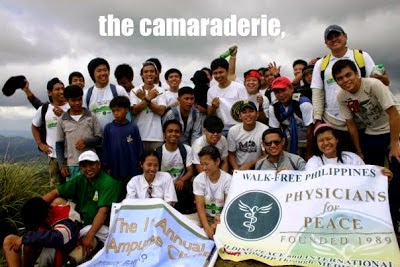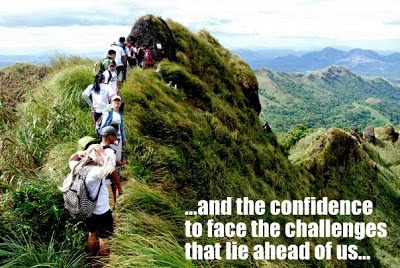TIPS ON TREKKING A MOUNTAIN
The Philippines is a prime spot for mountain hiking and nature trekking, with its large forest reserve areas, vast lowlands and foothills, and countless volcanoes. The variety of terrain seen along with the clear streams, waterfalls, and vegetation in the Philippines make it such an exciting place to partake in such a unique and challenging travel experience. Among the peaks you can explore are Taal Volcano, Mt. Apo, Mt. Pulang, and Mt. Mayon
-http://www.e-philippines.com.ph/
Mountain Hiking in the Philippines
 |
| Photo by: Google images |
Level 1 - Easy climb, best for beginners. Usually a one-to two- day climb.
Level 2 - Moderate climb, best for those with previous mountaineering experience or do it irregularly.
Level 3 - Hard climb, for hardcore mountaineers or regular trekkers with vast mountaineering experience.
Factors to consider when choosing your destination
Gideon Lasco, the author of Pinoymountaineer.com, devise a "relative" difficulty rating system that can be used to compare one mountain in the Philippines to another. The system is divided into three parts:
1. Classification (Minor-Major)
2. Difficulty Scale (1/9 being very easy; 9/9 technical)
3. Trail Class (1-5 which describes the type of trail to except).
This can be quite overwhelming for newbie, so far the purpose of this article, we can just use the "Minor-Major" classification in choosing mountains to climb.
 |
| Photo by: Google images |
A Major Climb normally requires two or more days to accomplish, with the climber exerting a great deal of physical effort, and normally takes six hours or more to reach the summit.
Tips in preparing for a mountaineering trip
Personal Health
As with any sport, before engaging in mountain climbing proper training and physical preparation is needed. For beginners, an easy and inexpensive way to get in shape is to go jogging 3 to 4 times a week before your scheduled outdoor climb. Another way to prepare your leg muscles is to do stair climbing, and as you stair climb you can wear a backpack and loaded with heavy books or liters of plastic water bottles to also target your shoulder back, leg muscles and knees. This way you cam get accustomed to carrying a heavy backpack as well.
Clothing
While hiking, wear quick dry clothes and stay away from cotton fabrics and denim pants since you will be sweating profusely during the climb. Wet clothes against your body can cause hypothermia especially during the portions of the trail where there are strong winds. For your headgear, wear a cap or a wide-brimmed bush hat for protection against the heat of the sun.
For cold nights at camp and for sleeping, you may use a jacket, bonnet, dry pair of socks, or anything that would keep you warm through the night.
Wearing a pair of hiking shoes is also advisable since you will be walking along a rocky and rugged terrain that normal shoes like rubber shoes or sneakers weren't designed for. Hiking shoes, with a pair of thick socks, also give you the advantage of overall protection for precious feet.
Photo by: http://www.walkflypinoy.com/
Photo by: Google image
Gear
Tents are not needed for day hikes. For climbs spanning from overnight to several days, bringing a tent is essential for a good night's rest. Decent tents can be bought from local outdoor shops, and you don't have to buy a top of the line foreign brand tent unless you are really serious about mountaineering.
Food
Food plays an important part of your planning. It id the source of your strength, fueling your body to continue the demanding task of mountain climbing. For meals, it is important that meal is easy to cook and require little water.
For day hikes, 1 to 2 liters of water per person would suffice, although you may need to bring more if it is in your nature to consume a great amount. Do take not however, that the more water you bring, the heavier your backpack becomes.
Companions and climbing buddies
Always hire a guide or go with an experienced mountaineer every time you climb mountains. Climbing alone increases the risks unless you are an experienced mountaineer with survival skills. Never venture into the woods without properly informing other people.
Itinerary
Creating an itinerary for your climb is also beneficial for success. This serves as your guide on what time you should be in a particular place and time you are expected to be back at the jump-off.
Precautions against risks and dangers
- To avoid dehydration especially during the summer months, always drink water and rehydrate every so often during water breaks at nearby water sources.
- To avoid hypothermia, wearing of proper warm clothes is also needed. Once you reach the camp, change in your dry clothes and let your wet clothes hang to dry.
- Always watch your step on and thread lightly in order to avoid sprained ankles and knees.
-Always bring a basic first aid kit. You can buy this in department stores and medicine drug stores. Don't forget to bring your personal medications if you have any.
Informations at http://www.travelbook.ph/media/articles/mountaineering-guide-for-beginners








No comments:
Post a Comment